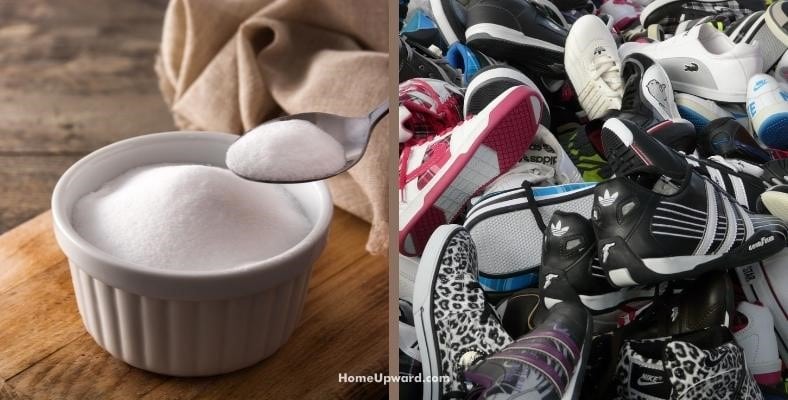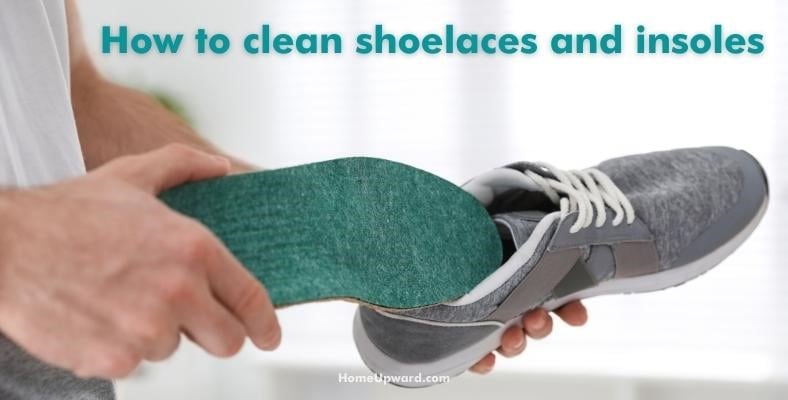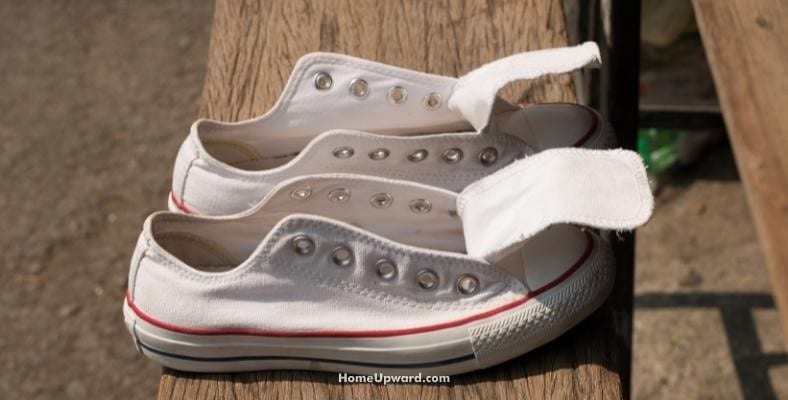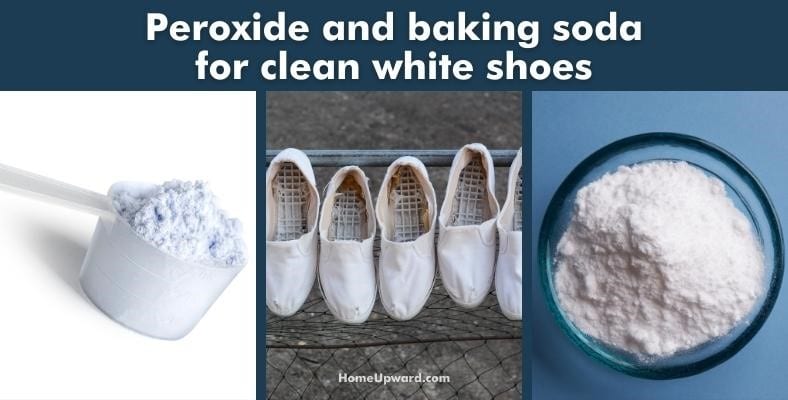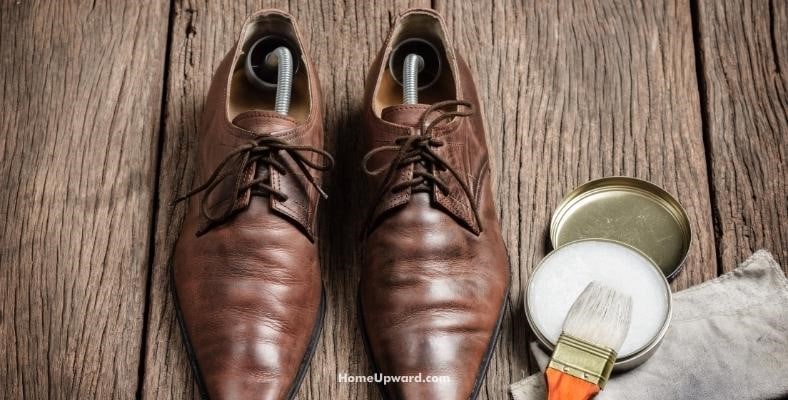Colored shoes can need a different approach when it comes to cleaning and stain removal. But how exactly and what cleaning items will you need?
I’ll show you exactly how to clean your colored shoes and a lot of other helpful tips as well.
Contents
How To Clean Colored Shoes With Baking Soda
Note: Be Careful With Baking Soda and Dark Colored Shoes
Baking soda can fade dark shoes a bit so it’s best to use caution when using it on your shoes. If the shoes are dark in color, then the best thing to do may be to only use dishwashing liquid on them to prevent any kind of fading.
Does Baking Soda Bleach Shoes?
Baking soda may or may not bleach them but it can fade them.
Items You’ll Need to Clean Colored Shoes With Baking Soda
Here is a list of things you can use when cleaning your colored shoes with baking soda, many of which you’ll probably already have around the house.
- Baking soda or bicarbonate of soda powder
- Toothbrush
- Dish soap or hand soap
- Small scrub brush or nail brush
- Microfiber or similar clean cloths
- Small bowl or cup
- Spray bottle
Steps for Cleaning Shoes With Baking Soda
Follow these steps to successfully clean your colored shoes using baking soda.
1. Remove the Inner Soles and Laces as Needed
If it’s possible to remove the inner soles and laces on your shoes that is the very best idea. Put both the laces and the inner soles in a laundry bag and drop them in the washing machine.
Using regular laundry detergent is fine for washing the laces and inner soles.
2. Wet the Shoes Lightly With Water
Using the water-filled spray bottle, lightly mist the outside of each shoe. The shoe should be damp, not sopping or overly wet.
3. Mix a Cleaning Solution (Dish Soap and Baking Soda)
Put equal parts dish soap and baking soda into a small bowl. About three tablespoons of each should be enough for one pair of shoes.
Then mix together the soap and the baking soda into a good paste.
When working with dark shoes, you’ll need a separate bowl of dish soap to clean the darker parts. Baking soda can fade dark colors so using only the dish soap is best.
If the shoes also have light parts that need to be cleaned, use the dish soap and baking soda paste you made earlier to clean them.
4. Clean the Inside of the Shoes With a Toothbrush
If the inner sole is being washed with the laces, move on to the next instruction. If not, use the dish liquid and baking soda to scrub the dirt and stains from the inner sole with a toothbrush.
5. Gently Clean the Outside of the Shoes With a Nail Brush
Using a nail brush or a toothbrush, scoop up a little bit of the baking soda and dish soap paste and scrub the outside of the shoe.
If these are dark shoes or you’re worried about fading, apply the paste only to the white parts of the shoes. Use only the dish soap for the dark or colored parts to prevent bleaching or fading.
If the sides or other rubber parts of the shoe or the sole are dirty using the paste on them will work great.
6. Let the Cleaning Solution Work
Leave the paste and/or the dish soap to work on the shoe for about an hour.
7. Rinse With Water
Use your spray bottle to gently mist the shoes with water to rinse them. Or, if you like, you can use a clean microfiber cloth to remove the paste.
8. Dry With a Clean Microfiber Cloth or Soft Towel
If you rinse the shoes with water a clean microfiber cloth or a soft towel works well to dry the shoes.
How to Clean Shoelaces and Insoles
The easiest way is to toss the shoelaces and the inner soles into a laundry bag and pop the bag into the clothes washer with normal detergent.
A laundry bag is especially helpful in keeping the laces from becoming a tangled mess. If the laces or inner soles are very dirty adding some baking soda to the cycle will add more power to the cleaning cycle.
How to Dry Shoes Properly
If you mist the shoes with water, using a clean microfiber cloth or a small towel should be enough to dry them. To speed up the process put them outside to dry.
Depending on the material the sun could fade them so it’s a good idea to keep them out of strong direct sunlight. Do be aware, however, that putting your shoes on an indoor heater or radiator can damage them.
Can You Put Shoes in a Clothes Dryer?
It depends. Leather shoes like moccasins, suede shoes, and shoes with synthetic materials won’t de well in a clothes dryer. For one thing, there’s a good chance they’ll shrink.
Any glues on the shoes could possibly melt, too, so that’s a big risk. Even if the shoes have small amounts of leather or synthetic material it’s a risk. Canvas shoes are best left to air dry.
If you do want to use a dryer for shoes, here are some possibilities:
Drying Rack
Some dryers come with a drying rack that can be used for shoes. Put the shoes inside the rack and operate as normal, choosing the best setting for the shoes. To learn more about drying racks, click here.
Hang the Shoes in the Dryer
- Untie the shoelaces and knot the ends of the shoelaces together.
- Have the shoes hanging inside the dryer. Close the dryer door with the ends of the shoelaces closed between the door and the dryer.
- Dry on the low setting.
- Hanging the sneakers inside the dryer prevents the shoes from tumbling around the dryer’s drum. It’s safer for both the shoes and the machine, not to mention much quieter.
- It’s best to stop the machine before the shoes are dry instead of drying them too much.
Big Sock
- This method is very quiet and also doesn’t hurt the dryer drum either.
- Use socks that are large enough to cover the sneakers. Put each of the shoes inside a sock.
- Start the dryer with a low setting.
- Alternatively, instead of a sock, use a traditional laundry bag or a pillowcase.
Towels
Put a full load of clean and dry towels into the drum then add the damp shoes. Again, choose a low setting and dry. This is a good idea when you’re drying athletic shoes.
Does Peroxide and Baking Soda Clean White Shoes?
Absolutely! What works very well is cleaning white sneakers with baking soda, hydrogen peroxide, and water. If needed, make the cleaning paste just with baking soda and water but no hydrogen peroxide.
In a non-metal bowl, mix together:
- ½ tablespoon warm water or 1 tablespoon you don’t have peroxide
- ½ tablespoon hydrogen peroxide
- 1 tablespoon baking soda
Stir the combination to make a good paste.
Next to clean the shoes:
- With a nail brush, scrub brush, or toothbrush, take some of the baking soda and hydrogen peroxide paste and brush it into the stains.
- Work the paste with a circular motion into the canvas.
- Allow the paste to dry for at least 30 minutes.
- Remove the extra paste after it has dried.
- Next, rinse the shoe with clean water or a wet rag or sponge.
- Repeat until the shoes are clean, the stains have vanished, and the result is gorgeous white sneakers.
For difficult stains like coffee or paint you may need to do this more than once. The hydrogen peroxide and baking soda solution may be a more effective choice for tougher stains than baking soda alone.
How Do You Clean White Shoes Without Baking Soda?
The surprising answer is toothpaste! White toothpaste is a good option for cleaning shoes without baking soda.
It can both cover a stain and remove it:
- Cover the stain quickly by putting a bit of toothpaste on a toothbrush and smoothing it gently over the stain.
- To clean your shoes, use white toothpaste that’s not a gel. If you can find one specifically for whitening that’s even better.
- Put the toothpaste on a toothbrush then work it into the stain using a circular brushing motion.
- Let the toothpaste stay on for 10-15 minutes, then wipe off the paste with a damp towel or a clean sponge.
- Keep reapplying the toothpaste until the stain disappears.
Toothpaste also brightens the rubber parts of sneakers including the white edges and toe area.


